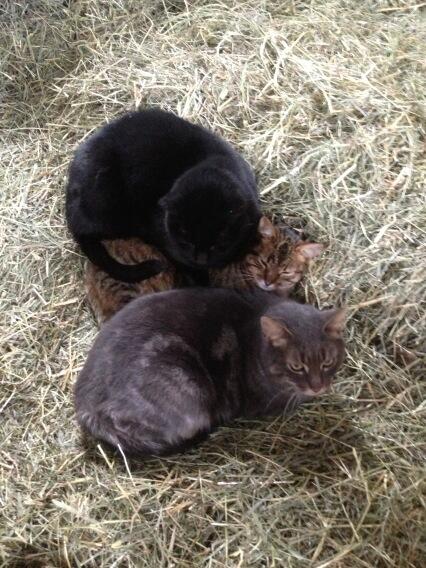Monday, May 12, 2014
Cats at the Farm
Written by Patrick Fox for the Wagner Tales Spring 2014 Issue
All of the animals at Wagner Farm, or any farm for that matter, serve a purpose. The cows are kept for their milk; the chickens for eggs; our Belgian draft horses Bob and Sue for pulling plows, wagons, or sleds. You may have wondered, however, why we have cats living on farms.
Unlike the other animals, cats are not livestock, meaning they’re not directly associated with the financial livelihood at the farm. This doesn’t mean we merely keep them as pets; they have a very important role on the Farm: controlling the rodent and bird population that preys on food supplies.
This has always been the role of our feline friends in our society going back thousands of years. When humans stopped living as hunters and gatherers and settled down in one place by adopting agriculture, their newfound abundance of food attracted mice, rats, and birds. Those animals wanted the grains set aside to feed people, and furthermore, the rodents spread disease to humans and their domesticated animals.
Fortunately, the collection of the mice and birds attracted wild cats to settled communities to prey on these small animals. Over time, these felines became comfortable around humans and developed a bond with their new companions. Thousands of years later, we have many different breeds of cats, and they are currently, believe it or not, the most popular pet in the United States.
Even though many cats today are purely pets living indoors, farms still rely on them to protect food supplies and prevent the spread of disease. Felines are great for farms not only for those reasons, but also because as carnivores, they have little interest in the grains, fruits, and vegetables grown that they are assigned to guard. Cats also get along well with the livestock, which are too large to be preyed on. I’ve personally seen the barn cats mingle with the cows.
Right now we have three barn cats at the Farm. You can usually find one or two of them hanging out in there, where we provide food and water dishes for them. During the winter they turn the stacked straw bales in the loft into their personal kitty condo which is surprisingly good at keeping them warm. Blackie (all black) is the oldest; he’ll be 8 years old this summer. Larry is a large dark grey cat with even darker stripes; he is about 5. Rascal is the youngest and the smallest; she’ll be 2 this June and her coat is a light grey with dark spots.
If you see the cats on one of your trips to the farm this summer feel free to pet them if they’re OK with it; if they walk away, however, they probably don’t want human interaction at the moment, and you should just let them be. Also, don’t chase them or scare them with loud noises because you might frighten them.
It’s easy to overlook the fact that the barn cats have an important role at Historic Wagner Farm, but we need to recognize the crucial protection felines on this and every farm in the world give to our food supply. Cats rule!
See the full Wagner Tales Spring 2014 issue.




